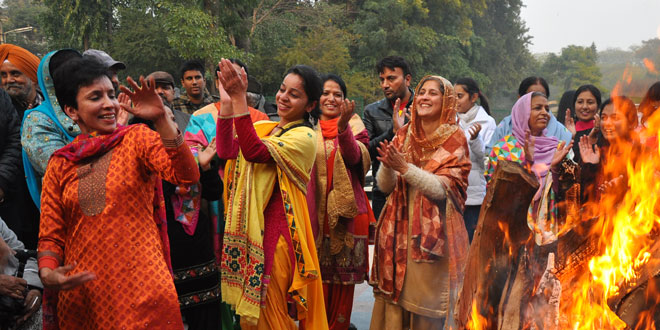Lohri Bonfire: Despite icy wind, the festive mood of Lohri is keep its warmth owing to its Bonfire celebration. It is an accepted fact that this festival is to worship fire. Lohri is not a religious festival, but a celebration marking the end of an intense winter and it also celebrates the sowing of the rabi crop. It celebrates the arrival of the new month and the new season and is a festival of happiness and anybody new in the family adds to it’s fervor.
Lohri Bonfire Harvest Festival Celebration:
Every year, Lohri falls on 13th January and right through the bitter winter day, men, women and children go around collecting dry twigs and branches to make a bonfire. The bigger the bonfire the better is Lohri celebration. Come evening and the bonfire is lighted with family and neighbors singing and dancing around it. The fire indicates the spark of life and prayers are said for goodwill and abundant crops. People gather round the bonfire and say prayers, and this is usually followed by dancing.
Huge bonfires are lit in the harvested fields and in the front yards of houses and people gather around the rising flames, circle around (parikrama) the bonfire and throw puffed rice, popcorn and other munchies into the fire, shouting “Aadar aye dilather jaye” (May honor come and poverty vanish!), and sing popular folk songs. During the parikrama it is traditional to throw popcorn, til, peanuts and jaggery into the fire. These are healthy winter foods and til is also considered to be holy.
After the parikrama, people meet friends and relatives, exchange greetings and gifts, and distribute prasad (offerings made to God). The prasad comprises five main items: til, gajak, jaggery, peanuts, and popcorn. Winter savories are served around the bonfire with the traditional dinner of makki-ki-roti (multi-millet hand-rolled bread) and sarson-ka-saag (cooked mustard herbs).
Punjabi celebrate Lohri every year with great enthusiasm as it is a festival of joy and it also heralds spring. Also, sowing of a crop is always a reason to celebrate in Punjab, where the majority of the population is into agriculture. People enthusiastically participate in the dancing that is held around the bonfire. Bhangra dance by men begins after the offering to the bonfire. Dancing continues till late night with new groups joining in amid the beat of drums. Traditionally, women do not join Bhangra. They hold a separate bonfire in their courtyard orbiting it with the graceful Gidda dance.
 Kids Portal For Parents India Kids Network
Kids Portal For Parents India Kids Network







